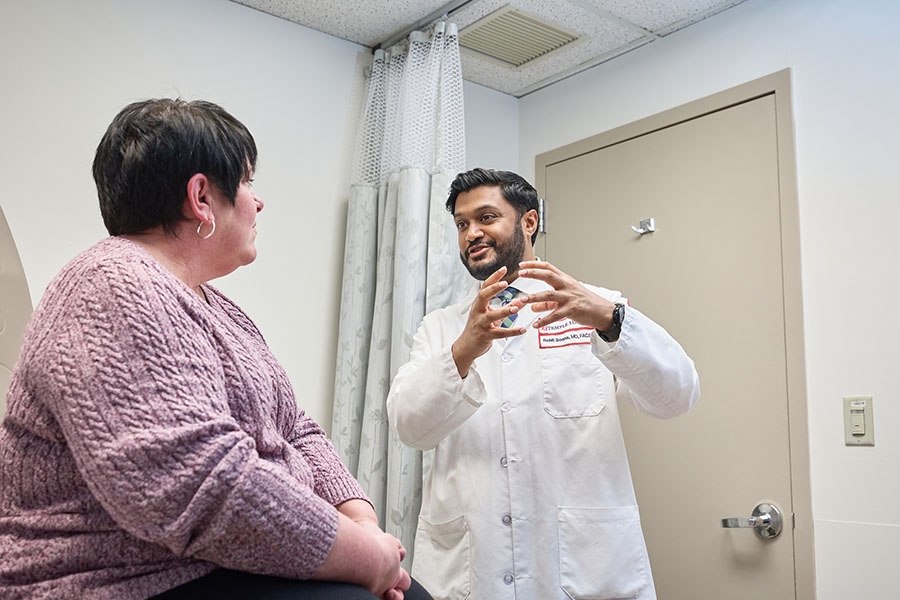As an orthopaedic sports medicine surgeon, I see and treat many anterior cruciate ligament (ACL) tears. These knee injuries occur frequently, and around 20,000 Americans each year undergo surgery for their ACL injuries. They are most often seen in young athletes but are increasingly affecting adults in their 40s and 50s.
Though ACL injuries are common, most people with suspected tears have a lot of questions about what caused the problem, how it can be fixed, and whether they'll be able to get back to their usual activities. Providing thorough answers is important: Regardless of a patient's age, ACL tears often require surgery to restore stability to the knee.
Here are some of the things many of my patients who come in with ACL tears want to know.
What is an ACL tear?
The knee joint consists of three bones: the femur (thighbone), the tibia (shinbone), and the patella (kneecap). These bones are connected by tough bands of tissue, called ligaments. There are four major ligaments that provide stability to the knee. The ACL is located in the center of the knee. It connects the femur to the tibia and controls back-and-forth movement as well as rotational movement, both of which are important for keeping the knee stable during cutting and pivoting activities.
ACL injuries occur when sudden stress is placed on the knee, causing the ligament to become stretched or torn. They typically happen when a person abruptly slows down or changes direction, which can cause the knee to twist. Landing awkwardly from a jump or colliding with someone else (like in a football tackle) can cause ACL tears too.
Orthopaedic specialists refer to injured ligaments as sprains. We determine how severe the sprain is based on whether the ligament is stretched (a grade 1 sprain), partially torn (grade 2), or fully torn (grade 3). Most ACL injuries are complete or near-complete tears, and they require ligament reconstruction surgery if the knee is unstable. But surgery may not be necessary if the ligament is only stretched, and the knee feels stable.
How can I tell if I have an ACL tear?
I can often tell a patient has an ACL tear when I listen to them describe how they got hurt. Most mention suddenly feeling their knee give out from under them — often while noticing a loud popping sound or sensation. This is usually followed by severe pain, swelling, and difficulty putting weight on their leg.
The initial pain and swelling from an ACL injury usually eases up on its own within a few weeks. However, a person may continue to experience a feeling of instability in the knee while walking or attempting other activities. They might also notice that their knee feels stiff or is not able to move as freely as before the injury. Treatment can help manage these problems, and in many cases, put an end to them altogether.
Am I more at risk for ACL tears?
Anyone can sustain an ACL tear, but some people are more prone to them. An individual has a higher chance of injuring their ACL if they:
- Participate in sports or activities that involve quick direction changes. Rapid pivots or start-stop motions cause about 70% of ACL injuries. Common culprits include football, basketball, soccer, or volleyball. People with strenuous jobs that involve climbing, jumping, or pivoting are also at increased risk.
- Are female. Females are four times more likely to sustain torn ACLs than males. This may have to do with anatomic factors, different physical conditioning, neuromuscular control, muscle strength, lower leg alignment, or even hormones such as estrogen.
- Are between the ages of 15 and 45. Adolescents and younger adults are more likely to get ACL injuries, simply because they are more likely to be active or involved in sports.
- Have torn their ACL before. Previously injured ACLs are more prone to tearing again, especially within the first year. People who have torn the ACL in one knee are at a higher risk of tearing the other ACL
How are ACL tears diagnosed?
Orthopaedic specialists can often spot an ACL tear just by conducting a physical exam. A knee with a torn ACL will look more swollen than the unaffected knee and will not have the same range of motion. Talking with the patient about how the injury happened, what it felt like, and whether they noticed that tell-tale popping noise can offer more clues.
In some cases, the physician might order imaging tests like an X-ray or MRI. These can rule out other possible reasons for a patient's pain and confirm that there are no broken bones. They can also be used to learn more about the severity of the injury, which can help inform treatment.
Can an ACL tear be fixed without surgery?
ACL tears sometimes require surgery, called ACL reconstruction surgery, in order to make the knee feel stable. However, I may recommend a nonsurgical option if a patient is older or is not very active, or if they feel like their knee is still relatively stable.
Wearing a brace and walking on crutches can stabilize the knee and limit the amount of weight placed on it while the swelling goes down. Once that happens, I recommend physical therapy and exercises to improve the knee's function and strengthen the surrounding leg muscles. It is a must for helping the patient get back to their daily activities.
When is surgery needed for an ACL tear?
Surgery is usually the best choice for athletes who want to get back to their sport. It is also often needed for individuals who are experiencing knee instability that gets in the way of their everyday activities.
Because ACL tears cannot be stitched back together, the ligament has to be surgically reconstructed with a tissue graft. The graft is placed where the old ACL was to restore stability and function. Grafts can be taken from the patellar tendon, hamstring tendons, or quadriceps tendon or from a cadaver. There are pros and cons to each graft choice, so patients should discuss the options with their surgeon.
Surgery is just the start of recovery, though. Once a patient's ACL has been reconstructed, they will need to perform months of physical therapy to restore their range of motion and build up the strength of their leg. Athletes will also need rehabilitation targeted toward their sport before they can return to play.
How can I determine the right treatment for my ACL tear?
The best treatment for an ACL injury depends on a patient's age, the severity of the tear, and the patient's future goals for athletics or physical activity. I have an in-depth discussion with each patient to decide on the best option for them.
Surgery is typically required for young athletes who want to return to their sport, especially agility sports. In many cases, it may also be the best option for those with partial or complete tears who want to stay active recreationally.
Some patients require special consideration before having surgery, however. Pre-teen and younger teen athletes with open growth plates may need modifications during ACL reconstruction surgery to prevent bone growth problems. Adults over 40 who are considering surgery need other imaging tests to confirm that they have little or no arthritis in their knees since arthritic knees generally do not benefit from ACL reconstruction.
Nonsurgical treatments can be effective for patients with ACL sprains who have stable knees. Older adults who are less active may be able to forgo surgery as well. It is important to keep in mind, though, that nonsurgical approaches place a person at higher risk of other knee injuries, such as meniscus tears.
When can I expect to recover from an ACL tear?
ACL tears can be serious, sidelining injuries. But with the right treatment and rehab program, most individuals can get their knee strength and function back within 9 to 12 months — and return to the sports or activities they love.
If you have experienced an ACL tear — or other knee injuries — the first step is a consultation with a specialist. You can schedule a consultation with the experts at Temple Health’s Orthopaedics & Sports Medicine Program online or by calling 800-TEMPLE-MED.
Helpful Resources
Looking for more information?


